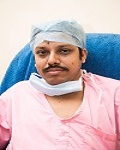Day 2 :
Keynote Forum
Yasser Zaghloul
Anesthesiology Institute – Sheikh Khalifa Medical City, UAE
Keynote: Does anesthesia have any effect on fertility?
Time : 09:45-10:30

Biography:
Dr. Yasser Zaghloul has completed his MBBCH, Ms. Sc, MD Ph.D., FCARCSI from Ireland he has been trained in anesthesia and critical care medicine in both Egypt and Ireland. He is the Consultant of Anesthesia; Sheikh Khalifa Medical City Abu Dhabi, UAE. He is the director of Abu Dhabi Anesthesia Club and Anesthesia Refresher Course he has extensive experience and interest in neuro-anesthesia & neurocritical care, neonatal & pediatric anesthesia, and perioperative medicine. He is a lecturer and instructor in the following international courses: FCCS, PFCCS, ENLS, Airway Management, Critical Care Nephrology, and mechanical ventilation courses. Previously he worked as a consultant of Anesthesia & ICU in Ireland and graduated in 1986 from Faculty of Medicine, Alexandria University Egypt.
Abstract:
World Health Organization (WHO) estimated that 234·2 million major surgical procedures are undertaken every year worldwide. All were done under general and/or regional anesthesia. About 59% of patients aged >15–59 years. On the other hand, management of pain and anxiety during oocyte retrieval makes anesthesia an important part of the in vitro Fertilization (IVF) procedures. There are many studies investigating the influence of anesthesia on IVF success. Evidence of serious toxicity in humans is not well established. The use of general anesthesia, especially nitrous oxide, for oocyte retrieval has an adverse effect on IVF outcome. This deleterious effect manifests itself only after embryo transfer and leads to lower pregnancy and delivery rates. Some anesthetic agents (propofol, thiopental, midazolam, fentanyl, and alfentanil) can accumulate in the follicular fluid. This can be used only as an indirect index of potential toxicity but cannot prove any real toxic effect on the outcome. Trials regarding different anesthetic techniques ended up without clear conclusions. Studies about General Anesthesia (GA) came up with conflicting results. A few trials relate GA with lower pregnancy rates, although some others failed to prove this conclusion. Furthermore, detectable amounts of some anesthetic agents are measurable in the follicular fluid but these findings are not strongly associated with toxicity. Monitored Anesthesia Care (MAC) and loco-regional anesthesia appears safe alternative choices and there is evidence of improved outcome.
- Effectiveness of sexual counseling based: PLISSIT model on sexual function of women with Polycystic Ovarian Syndrome
Location: 17:15-17:30
Chair
Fahimeh Golbabaei
Iran University of Medical Sciences, Iran
Session Introduction
S M Rahman
Cradle Fertility Centre, India
Title: IVF & PCOS: Management and solutions
Time : 12:20-12:45

Biography:
Abstract:
Ruhi Yasmin
Darbhanga Medical College and Hospital, India
Title: Polycystic Ovarian Syndrome and infertility
Time : 14:35-15:00

Biography:
Abstract:
Hassan El Motawakel Ala Allah Hassan Soliman
Saudi German Hospitals, Saudi Arabia
Title: An initial study to evaluate the role of laparoscopic ovarian drilling in ovulatory women: Polycystic Ovarian Syndrome

Biography:
Abstract:
Sini S Venugopal
Genix Fertility Care, India
Title: Recurrent implantation failure mainly with reference: PCOS

